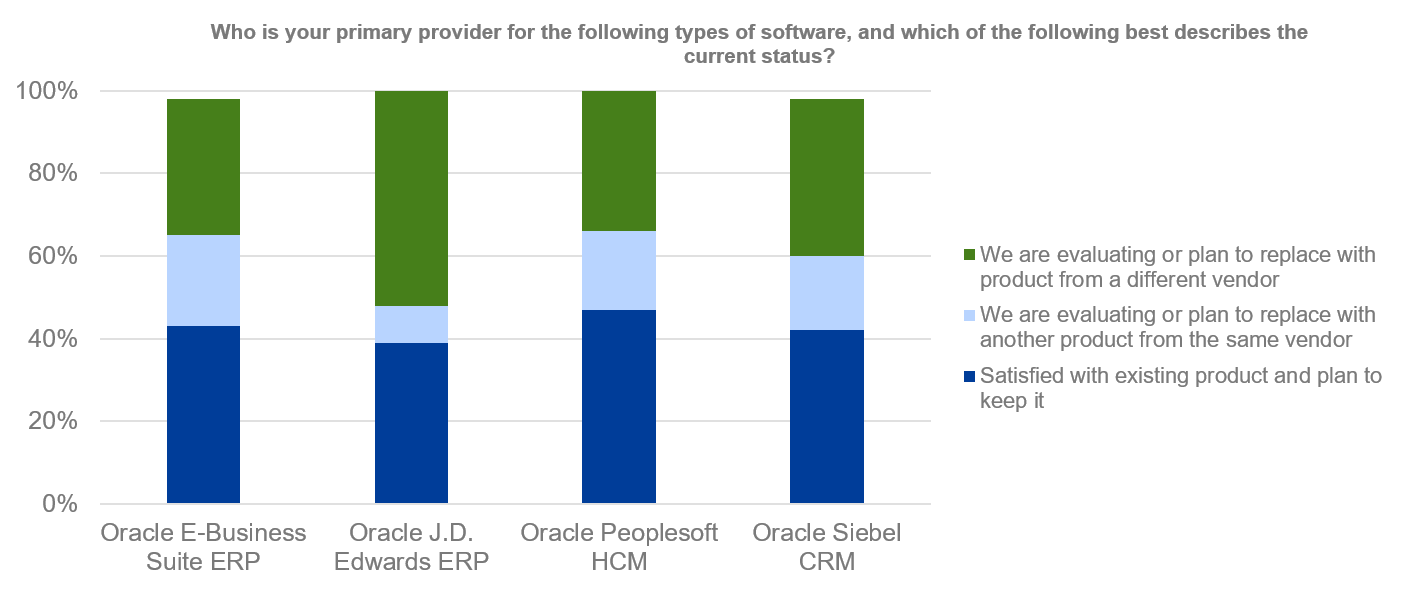Oracle’s Customers Can Benefit If Its Application Maintenance Stream Starts To Dry Up
Oracle customers should renegotiate their commercial relationships with this important vendor, using adoption of Oracle’s SaaS products as an incentive and cancellation of maintenance as a credible threat. Oracle’s SaaS strategy seeks to pull customers forward, but it has also undermined the value of its maintenance offering for its legacy on-premises products. Both factors increase customers’ negotiation leverage.
Oracle is determined to increase adoption of its SaaS products. In its last earnings call, Larry Ellison stated that ERP Cloud is one of two strategic imperatives for Oracle (Oracle’s autonomous database is the other). ERP Cloud comprises various finance and related products, such as Financials, Accounting Hub, Procurement, and Risk Management. It is one of five pillars in its SaaS portfolio (the others are CX, HCM, SCM, and manufacturing). There are several good reasons why you should take a serious look at Oracle’s SaaS portfolio:
- It’s a portfolio of products that you can use together or separately, not a monolithic omnisuite like its on-premises predecessors.
- Its Adaptive Intelligent Applications (AIA) strategy aligns well with Forrester’s vision for the future of business applications, as I explained in my recent webinar.
- Some of its products are leaders in their categories, particularly where the AIAs are strongest. For instance, in the recent report “The Forrester Wave™: Sales Performance Management Solutions, Q1 2019,” my colleague Mary Shea wrote, “ . . . the platform’s ability to turn large data sets into recommendations through ML [machine learning] is its biggest differentiator.”
However, Forrester’s survey data (from our Forrester Analytics Global Business Technographics® Software Survey, 2018) suggests that few Oracle customers are considering moving to its SaaS portfolio despite the above (see figure). Oracle needs to increase these adoption numbers without pushing customers to its rivals, which means there should be some good deals available for Oracle customers considering SaaS purchases.

Moreover, Oracle’s increased focus on SaaS also means that upgrade rights now have far less value than they previously did. Every Oracle applications customer should reassess the value of its maintenance offering and consider dropping maintenance and switching to a third-party support provider (3SP). Saving 50% or more of your maintenance bill will free up vital budget. There are many issues to consider before you make the move, but it can be a valuable bargaining chip. You would lose upgrade rights, but their value is:
- Questionable, even if you switch to Oracle’s SaaS portfolio. Oracle’s Customer 2 Cloud Program gives existing customers a discount against the equivalent SaaS product, but how big that discount is depends on many factors, such as how much you paid for your licenses. It may still be cheaper to drop maintenance now and negotiate a new purchase in a couple of years’ time, as if you were a new customer, especially if you’re paying maintenance for more users and products than you need. Note also that NetSuite is outside this program, so upgrade rights are worthless if that’s the Oracle product you’re considering.
- Insufficient if you keep using the legacy product. Oracle has shifted so much of its development focus to the SaaS portfolio that many customers of the legacy brands will decide that they aren’t getting enough ongoing enhancements to justify the maintenance charges.
- Nonexistent if you switch to a different vendor’s SaaS products. Customers in this bracket face the easiest decision: Why pay double or more for support if you plan to move away from Oracle anyway? Moreover, as I’ve just explained, you may still be better off dropping maintenance now even if you end up changing your mind and staying with Oracle.
Customers who construct a sound negotiation strategy, ideally combining possible SaaS purchases with the 3SP threat, may be able to persuade Oracle to reduce their maintenance burden. For instance, customers with a lot of shelfware may persuade Oracle to calculate maintenance based on what they are now using, rather than what they originally bought. Oracle will have to change its “all-or-nothing” maintenance repricing policy if enough customers choose nothing, plus sales teams will be pragmatic and flexible if there is SaaS revenue at stake.
Bottom Line
Oracle’s need for SaaS revenue and maintenance’s shrinking value give customers unprecedented leverage to renegotiate maintenance, if they use it wisely. Take closer looks at Oracle’s SaaS portfolio and the 3SP option so you can build a solid negotiation strategy that combines powerful incentives with credible threats. Speak with your Forrester account manager if you’d like to learn how we help clients do this.
